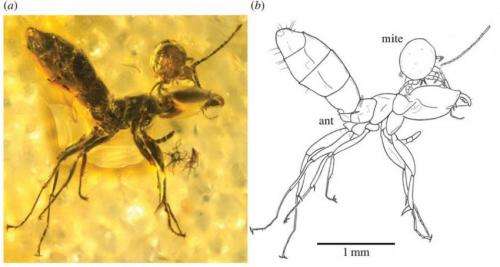September 10, 2014 report
50 million year old mite attached to ant head found in piece of amber

(Phys.org) —A small team of researchers with members from several countries has identified the oldest known instance of a type of mite fossil. In their paper published in the journal Biology Letters, the team describes how they obtained a piece of amber with an ant embedded inside of it along with a mite that was attached to the ant's head, and what their work revealed.
Mites are parasitic arachnids, and have been around for a very long time. Amateur arachnologist Jörg Wunderlich found the dime-sized piece of amber, but doesn't know where or when (he thinks maybe it was the Russian Baltic coast)—he has an extensive collection of amber. Noting that a mite was embedded inside, he passed the fossilized specimens on to Jason Donlop, a researcher with the Museum für Naturkunde and one of the members of the research team. After dating the amber back approximately 44 to 49 million years ago, the team realized it contained the oldest known mite fossil of its kind, Myrmozercon of the family Laelapidae.
The mite is clearly attached to the ant's head, but because it's embedded in amber, it's impossible to tell if the ancient mite was feeding on the ant's hemolymph (a sort of colorless blood) or if it was just hitching a ride. In either case, the fossil find offers proof that mites have been living with ants as far back as 50 million years ago. It also offers physical evidence of a rare specimen—there aren't many mite fossils, because they are tiny and are typically eaten after they die—specimens from only nine families which includes just four named species, have ever been found. In this case it appears that the mite attached itself to an ant and when that ant got stuck in a bit of tree resin, both became embedded inside—as the resin hardened and fossilized, both were preserved inside.
Understanding how mites evolved helps researchers understand mites that exist today, which is important because they attach themselves to bees, ants and other creatures, some of which play very important ecological roles—one type, for example, Varroa mites, are known to be honey bee pests and may be playing a role in colony collapse.
More information: An ant-associated mesostigmatid mite in Baltic amber, Biology Letters, Published 10 September 2014 DOI: 10.1098/rsbl.2014.0531
Abstract
Fossil mesostigmatid mites (Acari: Parasitiformes: Mesostigmata) are extremely rare, and specimens from only nine families, including four named species, have been described so far. A new record of Myrmozercon sp. described here from Eocene (ca 44–49 Myr) Baltic amber represents the first—and so far only—fossil example of the derived, extant family Laelapidae. Significantly, modern species of this genus are habitually myrmecophilous and the fossil mite described here is preserved attached to the head of the dolichoderine ant Ctenobethylus goepperti (Mayr, 1868). It thus offers the oldest unequivocal evidence for an ecological association between mesostigmatid mites and social insects in the order Hymenoptera.
Journal information: Biology Letters
© 2014 Phys.org




















